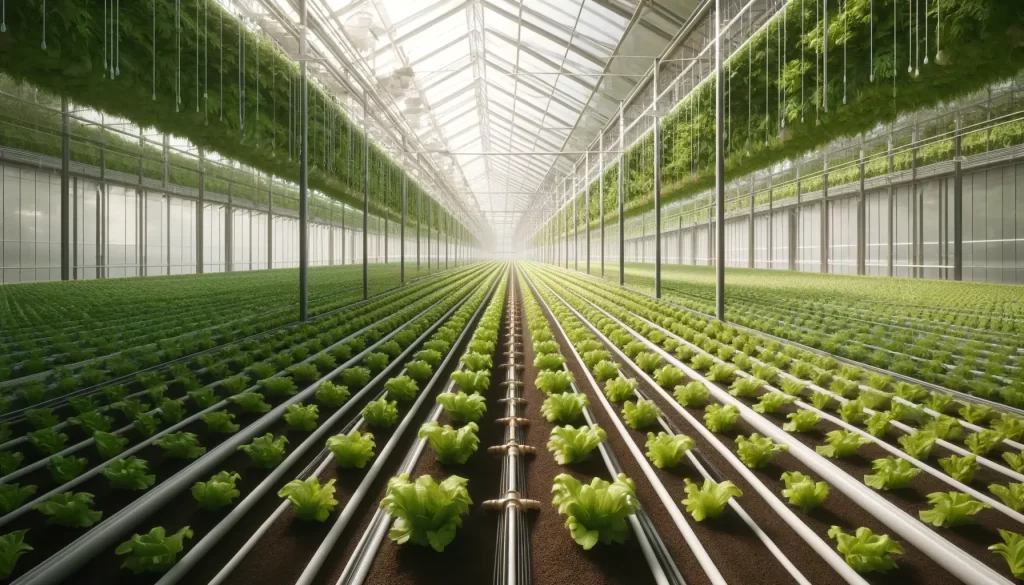Increasing productivity and maximizing profitability in agriculture has always been the primary goal. In this context, the use of liquid fertilizer has become an important trend in agricultural production in recent years. At Greenlive, we help farmers make the most of this trend by offering high-quality liquid plant nutrition products. Liquid fertilizers have many important advantages over solid fertilizers. These advantages, such as fast and easy absorption, high efficiency, improvement in product quality, less fertilizer use and ease of application, make liquid fertilizers an attractive option in agricultural production. However, it is also important to consider the economic aspect of using liquid fertilizer. The purpose of this article is to examine in detail the economic aspects of liquid fertilizer use, such as cost analysis and return on investment (ROI) calculations, and to present the advantages of Greenlive liquid plant nutrition products in this respect to our potential customers and dealers.
Increasing Popularity and Importance of Liquid Fertilizer Use
The popularity of liquid fertilizers in agricultural production has been increasing rapidly in recent years. The key factors behind this increase are:
- Quick and Easy Absorption: Liquid fertilizers are absorbed by plants much faster and easier because they are dissolved in water. In this way, the time it takes for nutrients to reach the plant is shortened and nutrient loss is minimized.
- High Yield: Fast and easy absorption of liquid fertilizers contributes to an increase in yield by allowing plants to access nutrients faster.
- Improvement in Product Quality: Liquid fertilizers provide a significant improvement in product quality by providing all the nutrients that plants need in a balanced manner.
- Less Fertilizer Use: Liquid fertilizers are more concentrated than solid fertilizers and therefore can be used in smaller amounts. This helps reduce fertilization costs.
- Ease of Application: Liquid fertilizers can be easily applied with modern irrigation techniques such as drip irrigation systems. This makes the fertilization process easier and more efficient.
Economic Advantages and Disadvantages of Liquid Fertilizers
It is known that liquid fertilizers have many economic advantages. Some of these advantages are:
- Lower Fertilizer Usage: Liquid fertilizers are more concentrated than solid fertilizers and therefore can be used in smaller amounts. This helps reduce fertilization costs.
- Less Application Cost: Liquid fertilizers can be easily applied with modern irrigation techniques such as drip irrigation systems. This makes the composting process easier and more efficient, thus reducing labor costs.
- Less Soil Erosion: Liquid fertilizers do not erode the soil and do not cause soil erosion when applied to the soil. This helps maintain the fertility of the soil in the long term.
- Less Environmental Impact: Liquid fertilizers cause less nitrogen loss compared to solid fertilizers. This helps reduce pollution of water resources and greenhouse gas emissions.
Purpose and Scope of the Article The purpose of this article is to examine in detail the economic aspects of liquid fertilizer use and to present the advantages of Greenlive liquid plant nutrition products in this regard to our potential customers and dealers. In the article, topics such as cost analysis of liquid fertilizers, return on investment calculation methods and things to consider in economic decision-making will be discussed. Additionally, information will be given about the economic benefits offered by Greenlive liquid plant nutrition products and the potential gains of cooperation with Greenlive.
Cost Analysis of Liquid Fertilizers
Determinants of Liquid Fertilizer Prices There are many factors that affect liquid fertilizer prices. Some of these factors are:
- Raw Material Prices: The main raw materials of liquid fertilizers are nutrients such as nitrogen, phosphorus and potassium. The prices of these nutrients in the world market directly affect the prices of liquid fertilizers.
- Production Costs: Production costs of liquid fertilizers include elements such as energy, labor and logistics. Increases in these costs may cause liquid fertilizer prices to increase.
- Demand and Supply: As demand for liquid fertilizers increases and supply remains constant, prices rise. Conversely, as supply increases and demand remains constant, prices fall.
- Brand and Quality: Liquid fertilizer prices of different brands and qualities may vary. Generally, more well-known brands and higher quality products have higher prices.
Cost Comparison of Different Types of Liquid Fertilizer
There are many different types of liquid fertilizers on the market, containing different nutrients and concentrations. These differences also affect liquid fertilizer prices. In general, liquid fertilizer prices increase depending on nutrient content and concentration. As the rates of main nutrients such as nitrogen, phosphorus and potassium increase and the concentration of fertilizer increases, prices also increase. Liquid fertilizers containing micronutrients and organic matter are also available. Prices of such fertilizers may vary depending on nutritional content and brand.
Cost Analysis of Liquid Fertilizers Compared to Solid Fertilizers
The cost of liquid fertilizers may be higher in some cases compared to solid fertilizers. Investment costs, especially in the first stage, may be higher for liquid fertilizers than solid fertilizers. This is because the production and transportation costs of liquid fertilizers are higher. However, there are many situations where liquid fertilizers are more economical than solid fertilizers in the long run. Factors such as the use of liquid fertilizers in smaller amounts, faster and easier absorption, less application cost and less soil erosion make liquid fertilizers more economical than solid fertilizers in the long run.
Greenlive Liquid Fertilizer Pricing Policy
As Greenlive, we aim to offer high quality liquid plant nutrition products to the market at the most affordable prices. Thanks to the high quality raw materials we use in our products and our advanced production techniques, we are able to offer competitive prices in the liquid fertilizer market. We also offer special pricing options and flexible payment terms to our customers.
Return on Investment (ROI) of Using Liquid Fertilizer
Effect on Increase in Yield and Product Quality
The quick and easy absorption of liquid fertilizers allows plants to access nutrients faster, contributing to an increase in yield. In addition, liquid fertilizers provide a significant improvement in product quality by providing all the nutrients that plants need in a balanced manner. Studies have shown that the use of liquid fertilizer can increase the yield of different agricultural products by an average of 5-15%. This increase also comes with a significant improvement in product quality.
Decrease in Irrigation and Fertilization Costs
Liquid fertilizers can be easily applied with modern irrigation techniques such as drip irrigation systems. This makes the composting process easier and more efficient, thus reducing labor costs. Additionally, liquid fertilizers can be used in smaller quantities, which helps reduce fertilization costs.
Protects Soil Health and Provides Long-Term Benefits
Liquid fertilizers do not erode the soil and do not cause soil erosion when applied to the soil. This helps maintain the fertility of the soil in the long run. Additionally, liquid fertilizers help reduce the pollution of water resources and greenhouse gas emissions by reducing nitrogen loss.
Return on Investment Calculation Methods and Examples
Different methods can be used to calculate the return on investment (ROI) of using liquid fertilizer. One of the most commonly used methods is cost-benefit analysis. In cost-benefit analysis, the benefits obtained by using liquid fertilizer (yield increase, product quality increase, cost savings, etc.) are compared with the cost of using liquid fertilizer. The net benefit obtained represents the ROI of using liquid fertilizer. For example, let’s assume that the use of liquid fertilizer in a one-hectare tomato field results in a 10% increase in yield and a 5% increase in product quality. Let’s also assume that using liquid fertilizer saves 10% in fertilization costs and 5% in irrigation costs. Let the cost of liquid fertilizers be 100 TL per hectare. In this case, the net benefit of using liquid fertilizer is calculated as follows:Net Benefit = (Yield Increase x Product Price) + (Product Quality Increase x Product Price) – (Fertilization Cost Savings) – (Irrigation Cost Savings) – Liquid Fertilizer CostNet Benefit = (0.1 x 5000 TL) + (0.05 x 5000 TL) – (0.1 x 100 TL) – (0.05 x 100 TL) – 100 TLNet Benefit = 500 TL + 250 TL – 10 TL – 5 TL – 100 TLNet Benefit = 640 TL In this example, a net benefit of 640 TL per hectare was achieved by using liquid fertilizer. This shows that using liquid fertilizer provides 640% ROI.
Recommendations for Maximizing Return on Investment
To maximize the return on investment (ROI) of using liquid fertilizer, you can follow these recommendations:
- Choose the right type of liquid fertilizer: Choose the type of liquid fertilizer that contains the nutrients your plants need and is suitable for your soil type.
- Use the right amount of liquid fertilizer: Using more liquid fertilizer than the plants need will both harm the environment and increase your costs.
Things to Consider in Economic Decision Making
Some important factors need to be taken into consideration when evaluating the use of liquid fertilizer economically and calculating the return on investment (ROI). Some of these factors are:
Regional Factors and Agricultural Production Conditions
Different regions have different soil types, climatic conditions and agricultural production practices. These factors can affect the effectiveness and ROI of liquid fertilizers. Therefore, regional factors and agricultural production conditions should be taken into account when making economic decisions regarding the use of liquid fertilizer.
Plant Types and Fertilization Needs
Different plant species have different nutrients and fertilization needs. Therefore, the choice of liquid fertilizer and the amount of application should be determined by the plant type. Otherwise, the effectiveness of liquid fertilizers may decrease and ROI may decrease.
Application Techniques and Equipment Costs
The effectiveness and ROI of liquid fertilizers also depend on the application techniques and equipment used. With modern irrigation systems and correct application techniques, the effectiveness of liquid fertilizers can be increased and ROI can be increased.
Government Incentives and Subsidies
In some countries and regions, government incentives and subsidies are offered to encourage the use of liquid fertilizer. These incentives and subsidies can increase the economic attractiveness of liquid fertilizer use and increase ROI.
Thinking Long Term
When making an economic evaluation of the use of liquid fertilizer, not only short-term benefits but also long-term benefits should be taken into account. It should be noted that liquid fertilizers help maintain soil health and increase long-term productivity. The use of liquid fertilizer has become an economically attractive option that provides many important advantages in agricultural production. Advantages of liquid fertilizers such as fast and easy absorption, high efficiency, improvement in product quality, less fertilizer use and ease of application make these fertilizers indispensable in agricultural production. However, it is also important to consider the economic aspect of using liquid fertilizer. The initial investment cost of liquid fertilizers may be higher than solid fertilizers. Additionally, liquid fertilizers are more difficult to store and transport than solid fertilizers. However, there are many situations where liquid fertilizers are more economical than solid fertilizers in the long run. Factors such as the use of liquid fertilizers in smaller amounts, faster and easier absorption, less application cost and less soil erosion make liquid fertilizers more economical than solid fertilizers in the long run. At Greenlive, we help farmers make the most of the benefits of using liquid fertilizer by offering high-quality liquid plant nutrition products. Our products help farmers increase their profitability by providing higher yield and product quality compared to solid fertilizers . We also offer special pricing options, flexible payment terms and technical support to our customers. You can contact us to get more information about the use of liquid fertilizer and detailed information about our Greenlive products.
Frequently Asked Questions (FAQ)
What is Liquid Fertilizer?
Liquid fertilizer is a type of fertilizer consisting of nutrients dissolved in water. Compared to solid fertilizers, it is absorbed more quickly and easily and can be used in smaller amounts.
What are the Benefits of Using Liquid Fertilizer?
- Quick and easy absorption
- High efficiency
- Improvement in product quality
- Low fertilizer use
- Ease of application
- Protecting soil health
- Environmentally friendly
What are the Disadvantages of Using Liquid Fertilizer?
- Investment cost in the first stage may be higher
- Storage and transportation challenges
- Application timing may be more limited
Is Liquid Fertilizer More Expensive Than Solid Fertilizers?
In some cases, the initial investment cost of liquid fertilizers may be higher than solid fertilizers. However, there are many situations where liquid fertilizers are more economical than solid fertilizers in the long run.
How to Choose Liquid Fertilizer?
Some factors to consider when choosing liquid fertilizer are:
- Contains the nutrients that plants need
- Suitable for your soil type
- Being from a quality and reliable brand
How Much Liquid Fertilizer Should Be Used?
The use of liquid fertilizer may vary depending on plant type, soil type and season. It is important to carefully read and follow the instructions on the product label for the amount of use.
How to Apply Liquid Fertilizer?
Liquid fertilizers are generally applied via drip irrigation systems. It can also be applied by foliar feeding method.
What Should You Consider When Using Liquid Fertilizer?
- Carefully read and follow the instructions on the product label.
- Use the correct amount of liquid fertilizer.
- Apply liquid fertilizer at the appropriate time.
- Store and use safely and healthily.










